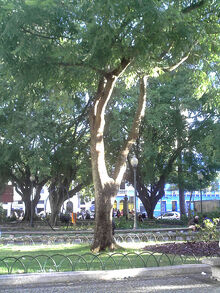The Plant[]

The brazilwood tree may reach up to 15 metres in height, and the dark brown bark flakes in large patches, revealing the lustrous blood-red heartwood underneath. The leaves are pinnate and each consists of between 9 and 19 small, leathery leaflets, which are broadly oblong in shape. The flower stalk, or inflorescence, is also branched and contains between 15 and 40 yellow, strongly perfumed flowers, which may be pollinated by bees.The petals are usually yellow with a blood-red blotch.The fruits are oval-shaped woody seedpods, measuring up to 7.3 cm long and 2.6 cm across; they hang off the branches and after the seeds are expelled, the pods become twisted in shape.The branches, leaves and fruit are covered with small thorns. [1]
How to Harvest[]
Brazilwood is harvested from old-growth trees originally found in tropical forests. Harvesting in old-growth forests can be devastating to their ecosystems, but there are fair trade, sustainable sources of brazilwood. [2] Brazilwood is usually sold as heartwood chips or sometimes as a powder. [3]
How to Extract Color[]

Wood chips are pounded and then soaked in water for up overnight, up to a week. A range of reds and purples can be produced, depending on the soak time and pH of the dyebath. An acidic bath will produce yellows, oranges, and brown-pinks. An alkali bath will produce deep reds to purples. Clear, bright colors can be obtained by extracting the pigment with alcohol. Colors are not particularly light-fast. [3]
References[]
- ↑ Lewis, G.P. (1998). Caesalpinia: a revision of the Poincianella-Erythrostemon Group. Kew: Royal Botanic Gardens.
- ↑ Duerr, S. (2010). The handbook of natural plant dyes: Personalize your craft with organic colors from acorns, blackberries, coffee, and other everyday ingredients. Portland, Or.: Timber Press.
- ↑ 3.0 3.1 Cannon, J., & Cannon, M. (1994). Dye plants and dyeing. Portland, Or.: Timber Press.